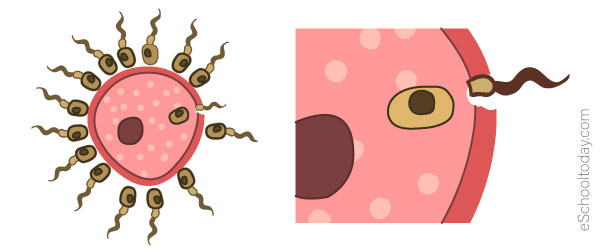- Reproduction
What is Fertilization?
From the previous page, we mentioned that the sperm cell is released into the female organ. The cells make their way through to the top of the vagina, through the cervix, and into the uterus. But they do not stay there — they continue their journey into the fallopian tube and travel upward.
If there is any ovum (egg cell) released, the egg cell and the sperm cells meet. The ovum is released by the ovaries in a process called ovulation.
Now hold on, because this is not fertilization yet!
When they meet, there are millions of sperm cells, and they will all meet the only egg. When the sperm cells meet the egg, only the sperm cell that can break through the egg membrane wins! Then, the egg nucleus meets the sperm nucleus, and fertilization occurs. A new life begins, and the female is pregnant now.

In the diagram, notice how millions of sperm cells all trying to break through the membrane of the egg cell.
Sometimes, none of the sperm cells is strong enough to break through the egg membrane. If this happens, both male and female cells just dissolve and get washed away. Once one sperm has fertilized the egg, it is too late for the other sperm cells. No other sperm cell can get in.
Once a sperm cell fertilizes an egg cell, it becomes a zygote. The zygote (fertilized egg) at this stage possesses half the DNA (characteristics) of each of its two parents. The zygote then divides itself to form a very tiny ball called an embryo. The embryo continues downwards and finds itself in a comfortable place in the uterus. There, the embryo attaches itself to the lining (walls) of the uterus and begins to grow there.
